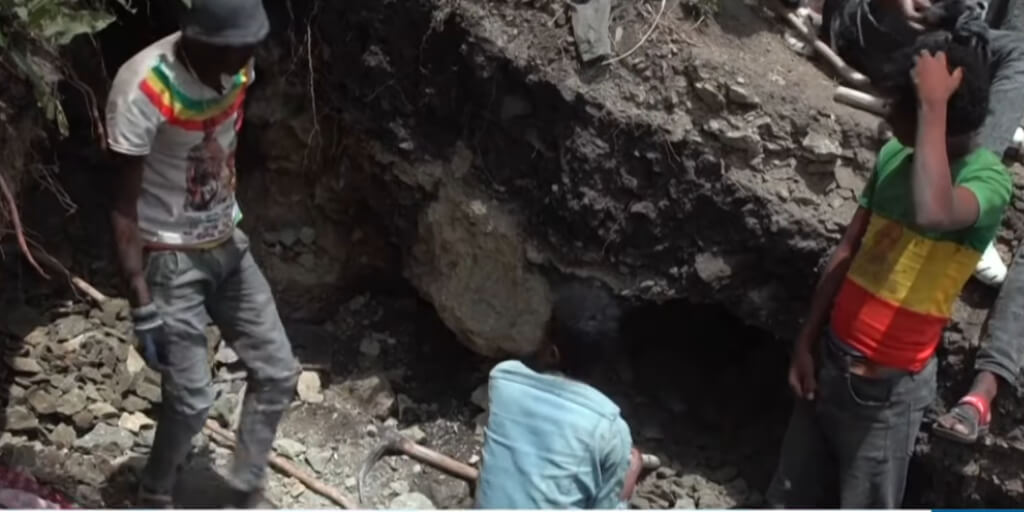Collapse of crop tests farming communities in Eastern Hararghe
Kalkidan Yibeltal
Standing at the doorway of the mud-walled, tin-roofed office in Ordee Goba Farming Kebele in eastern Hararghe of the Oromia regional state, the development agent (DA) pointed at the crops – mainly sorghum and maize – inside the compound; a look of disappointment and helplessness is stamped all over his face. It needed no effort to notice the stunted stems and the dry leaves.
“This is our demonstration farm where we cultivate newly bred seeds with high yielding capacity [to display to the farmers]” he said, nervous about disclosing his name; (wandering around as journalists was not the safest thing to do either). “But as you can see, we don’t have much to show this year. What good are the seeds without rain?”
This time of the year, under normal circumstances, would have been marked by merriment and abundance as the farmers harvest their crops. Additionally, the Kebele was known for its high output as the development agent explained. “There were times when we managed to produce 30 quintals [of sorghum] per hectare,” he said. It took severe shortages of rainfall in two consecutive seasons for an unfortunate reality to descend; its 1,450 residents are now left at the mercy of aid.
When it had become clear that the amount and timing of rain could not sustain long cycle Meher crops like sorghum and maize, early maturing varieties were distributed for re-plantation. (Planting of Meher crops was incredibly delayed thus causing failure of germination as well as dying and wilting of the crops after germination and at the vegetative state.) But the re-plantation couldn’t yield products as hoped. “There isn’t a single fault on the farmers’ part,” the DA defends the farmers. “They have done all they could. It was only God’s [blessing] they lacked.”
Kurfa Chele’s Lot
In Eastern Hararghe Zone of the Oromia Regional State, Meher contributes about 80 per cent of the annual crop production. In many of the Woredas in the zone, the Belg rain which is very important for land preparation and planting of long cycle Meher crops was late by 6-8 weeks according to an Assessment Report prepared jointly by government bureaus, Non-Governmental Organizations working in the area and various United Nations agencies including WFP and FAO.
The Meher rain, which typically begins around June and continues to September, was late by two weeks in some areas while in others it started normally. The amount and distribution, however, was much below the regular. There was long dry spell of 6 to 8 weeks from July to Mid-August.
Of the 362,451 hectare cultivated and planted in the Zone during the 2015 Meher season only 27.2 per cent of the planted crop (147,308 hectare) is found in good condition. The crop planted on 36.12 per cent (130,923 hectare) is totally damaged and 37 per cent (161,288 hectare) is wilted due to the long dry spell and inadequate moisture, the assessment report states. Thus, the food security situation in the Zone is one of the worst in the past decade.
The total production plan for Meher was 11,858,637 quintal. However a recent pre-harvest assessment conducted in all the Woredas of the Zone puts the anticipated yield at 3,091,457 quintal which is just 26% of the plan. (For comparison last year’s Meher yield was 7,025,471 quintals; the five year average stands at 5,353,529 quintals.)
In Kurfa Chele, one of the nineteen Woredas in the Zone and wherein Ordee Goba rural Kebele is found, the situation is worse. The Woreda’s anticipated yield is only 6,502 quintals as compared to last year’s 188,853 quintals. Of the 63,804 rural population of the Woreda 32,753 are in need of emergency food aid as of the end of October and the number is expected to rise to 49,753 by December, which is roughly 77 per cent of the entirety.
Water availability, both for humans and livestock drinking, is one of the major issues. In one rural Kebele, for instance, a pond which has served the community for 32 years had dried down, forcing women to walk long distances to fetch potable water.
Mass migration of livestock is also happening due to shortage of water and pasture; many from Kurfa Chele are moving to neighboring areas like Kosum and Gobelle.
The development agent in Ordee Goba is naturally distraught by the trying times his community is enduring. So far, an NGO operating in the Woreda had provided five rounds of emergency food aid for 650 people, he said. Additionally 75 families were recipients of government aid “a month ago.” About 75 ETB (US$ 3.50) contingency payments for each member of a given family was paid in cash. However “there are still 872 people in our Kebele who have not received assistance of any kind.”
Nine hundred ninety six people are expected to be included in the fourth installment of the Productive Safety Net Program (PSNP) which will kick off in January next year, a fact not entirely exhilarating for the DA. “It is the first time that we [in Ordee Goba rural Kebele] have to be included in the [PSNP],” he said.
According to him, nine truckloads of livestock feed were distributed to the farmers. Another (former) development agent sees hope in the livestock production of the Kebele. “Many of the crops are destroyed [in their vegetative state],” he said. “They are good for nothing except for animal feed.”
Since income from cash crops was heavily affected by the drought (Khat and groundnut production was severely hindered), locals had to look for other ways to make an earning. In Ordee Goba, like in many other rural Kebeles in Kurfa Chele, some have decided to increase the amount of livestock sales to make a living. The collection and sale of firewood as well as migrating to neighboring towns looking for jobs as day laborers are what many others preferred. But both will have lasting impacts.
“There are many people going to Haramaya [a small neighboring town about 35 km away]. Some others go as far as Harar [the capital of the Harari Regional State about 60 km to the East]. They look for jobs in buildings being constructed,” said the DA. (The Assessment Report prepared by government offices, NGOs and UN agencies mentions of a woman who left Kurfa Chele Woreda in search of daily labor but who ended up dead from a car accident.)
As of mid-November there was no reported outbreak of threatening livestock diseases. There were also no human deaths or diseases outbreaks. However, malnutrition case continued with high admission rate as stated in a situation report compiled by an NGO operating in the Woreda. But both the DA and the former DA were apprehensive of the future. They don’t see their communities returning to normal conditions anytime soon. For now all they could hope for was a timely and adequate food aid delivery.







